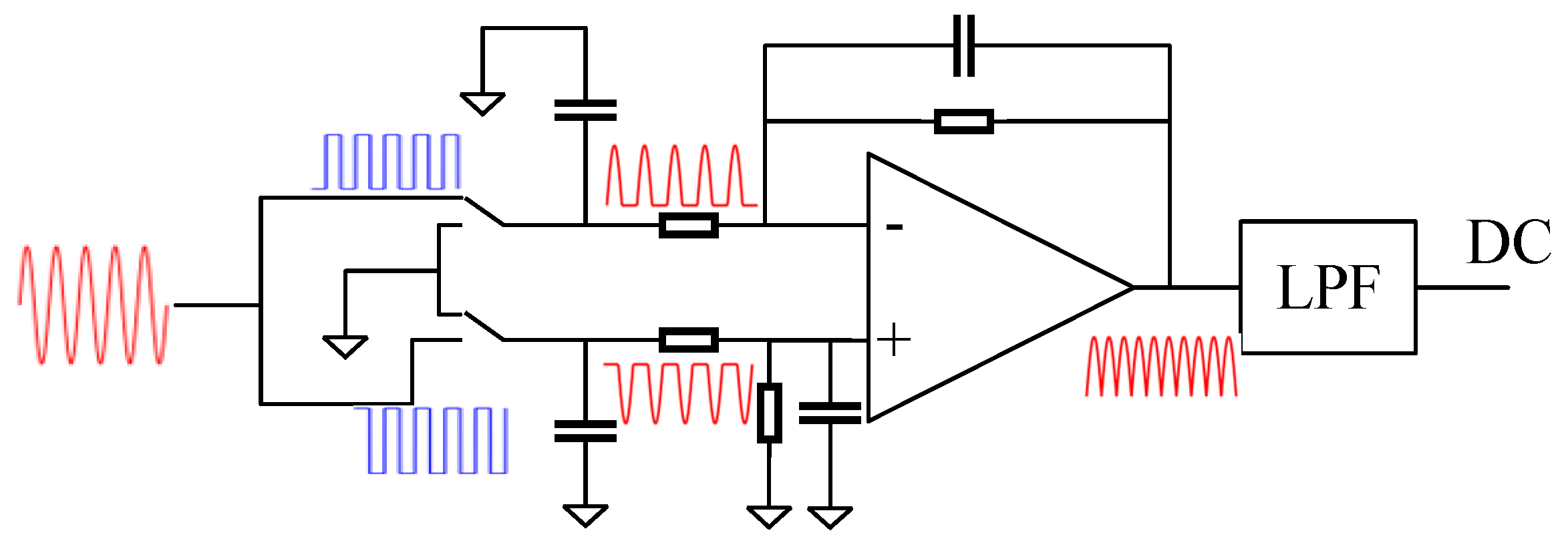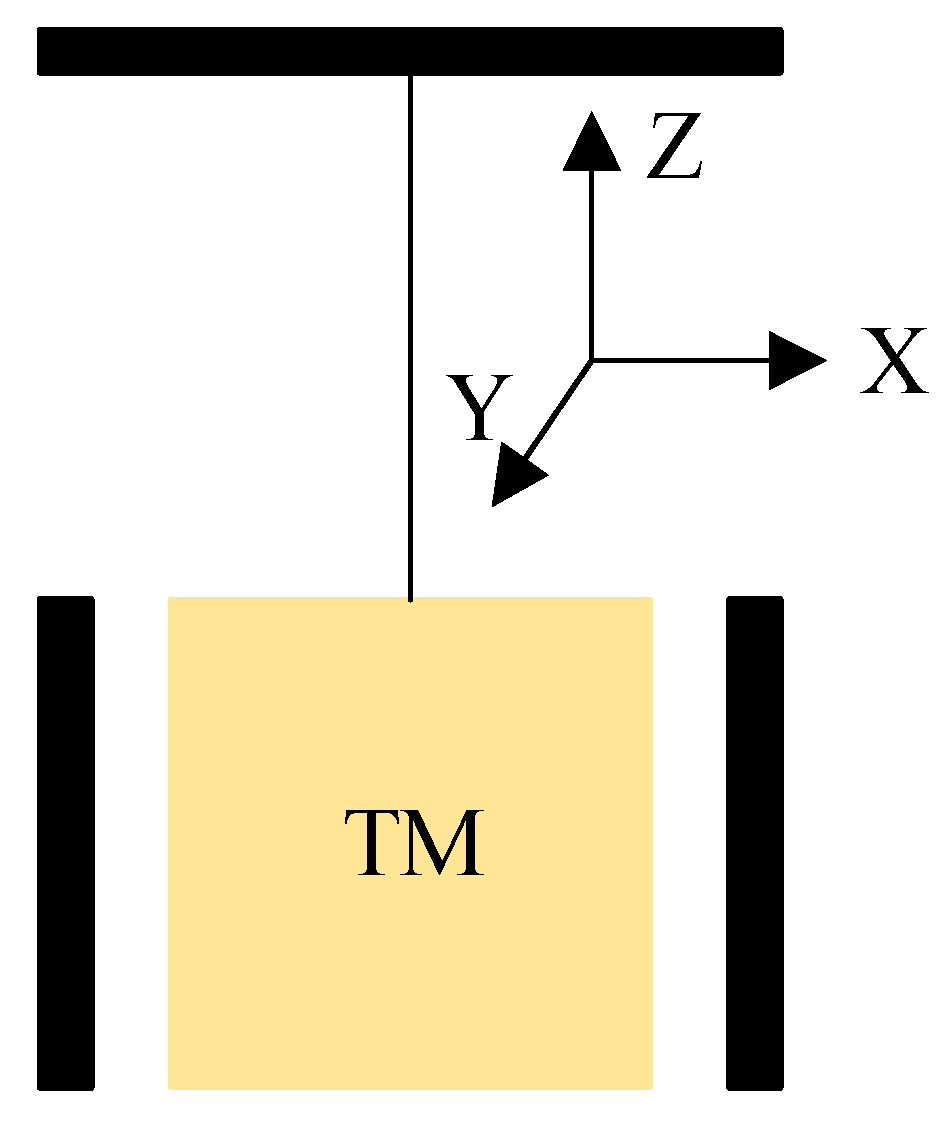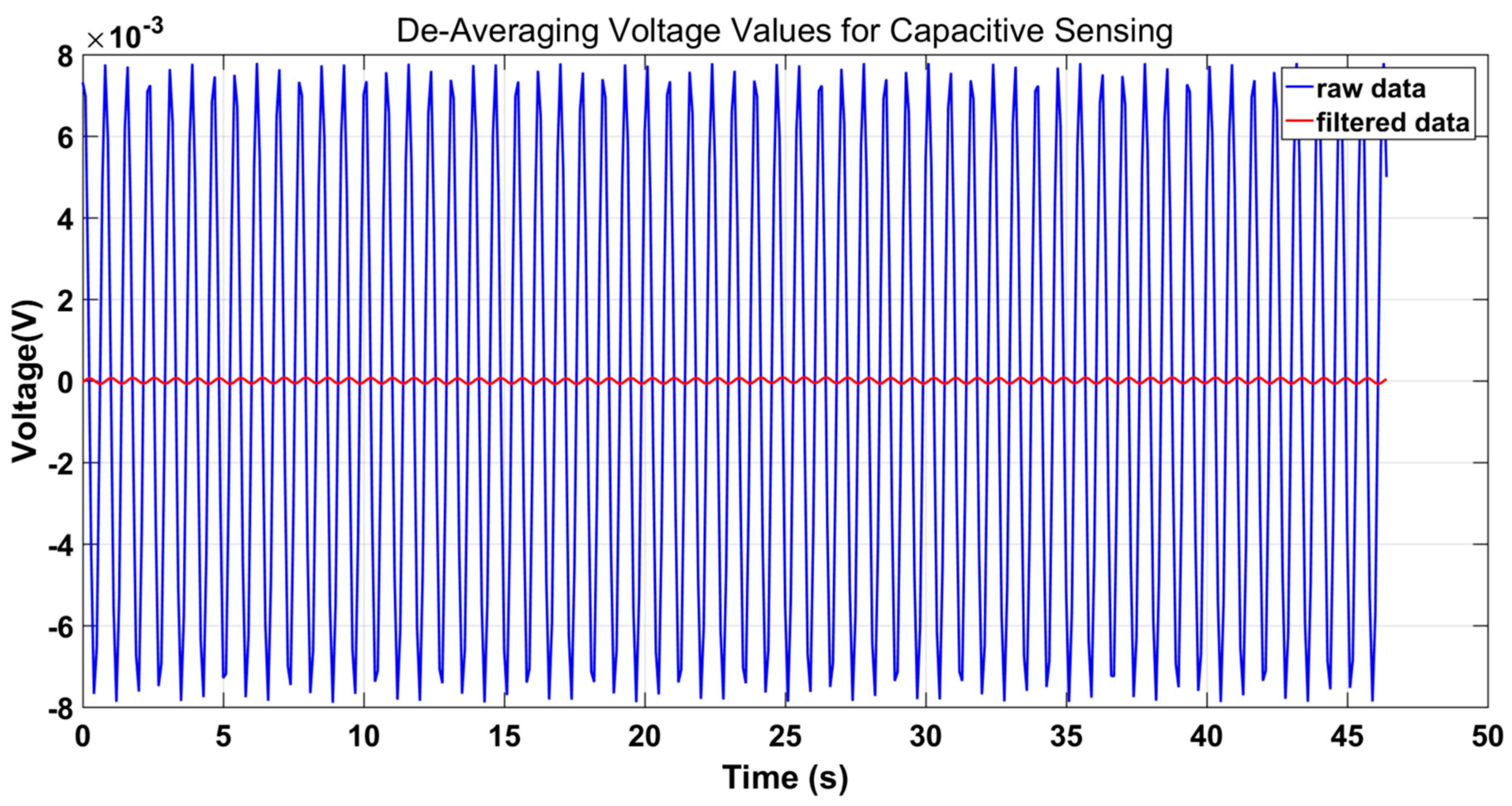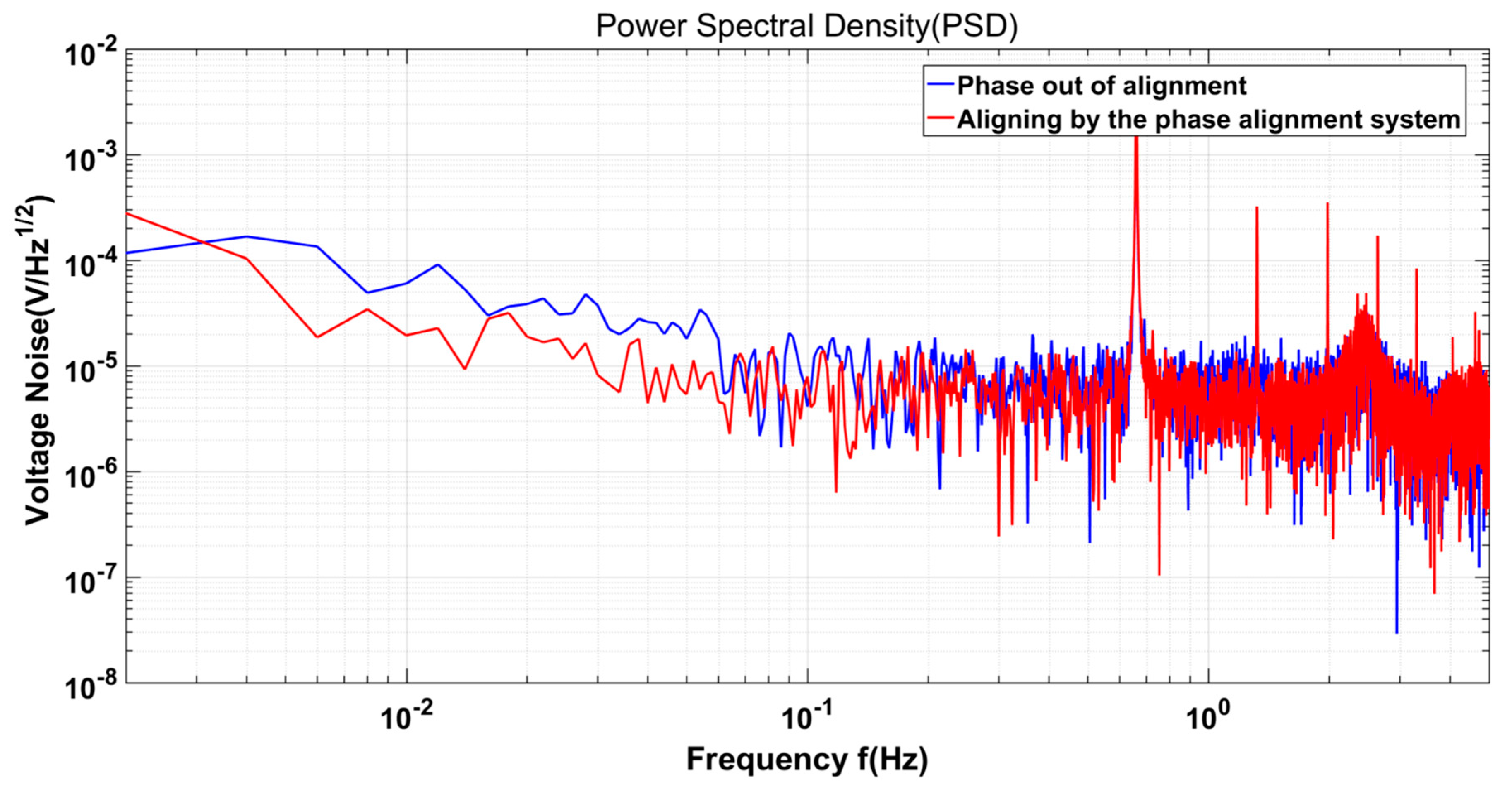Research and Implementation of a Demodulation Switch Signal Phase Alignment System in Dynamic Environments
Abstract
:1. Introduction
- (1)
- This paper introduces phase alignment system in dynamic environments, to solve the difficulty of phase adjustment. The system can determine the phase difference by shifting the phase of the demodulation switch signal by , thereby achieving a precise phase alignment of the signal.
- (2)
- We create a simulated dynamic environment to test the phase alignment system. The experimental results demonstrate that the system can accurately align the phase of the demodulation switch signal even in the presence of dynamic environmental interference.
- (3)
- This paper introduces a method for measuring phase deviation. Through adjusting the amplitude of the injection voltage, the phase deviation of the demodulation switch signal is ultimately fitted.
2. Synchronous Demodulators in Dynamic Environments
2.1. Working Principle of Capacitor Sensors
2.2. Working Principle of Synchronous Demodulations
2.3. Effect of Dynamic Environments on Phase Alignment
3. Phase Alignment System Design
3.1. AD Module
3.2. LPF Module
3.3. CORDIC Module
3.4. Demodulation Switch Signal Module and Injection Voltage Module
3.5. RS-422 Module
4. Measurement Results and Discussion
4.1. Static Environment Testing
4.2. Dynamic Environment Testing
5. Conclusions
Author Contributions
Funding
Conflicts of Interest
References
- Danzmann, K. LISA mission overview. Adv. Space Res. 2000, 25, 1129–1136. [Google Scholar] [CrossRef]
- Hu, W.R.; Wu, Y.L. The Taiji Program in Space for gravitational wave physics and the nature of gravity. Natl. Sci. Rev. 2017, 4, 685–686. [Google Scholar] [CrossRef]
- Gong, Y.; Luo, J. Concepts and status of Chinese space gravitational wave detection projects. Nat. Astron. 2021, 5, 881–889. [Google Scholar] [CrossRef]
- Luo, J.; Chen, L.S.; Duan, H.Z.; Gong, Y.G.; Hu, S.; Ji, J.; Liu, Q.; Mei, J.; Milyukov, V.; Sazhin, M.; et al. TianQin: A space-borne gravitational wave detector. Class. Quantum Gravity 2016, 33, 035010. [Google Scholar] [CrossRef]
- Jennrich, O. LISA technology and instrumentation. Class. Quantum Gravity 2009, 26, 153001. [Google Scholar] [CrossRef]
- Sui, Y.; Yu, T.; Wang, L.; Wang, Z.; Xue, K.; Chen, Y.; Liu, X.; Chen, Y. Analysis of a Capacitive Sensing Circuit and Sensitive Structure Based on a Low-Temperature-Drift Planar Transformer. Sensors 2022, 22, 9284. [Google Scholar] [CrossRef]
- Mance, D. Development of Electronic System for Sensing and Actuation of Test Mass of the Inertial Sensor LISA Razvoj Elektroničkog Sustava za Očitavanje i Pokretanje Test Mase Inercijalnog Senzora LISA, 2012. Available online: http://spaceserv1.ethz.ch/aeil/download/Davor_Mance_Thesis_text.pdf (accessed on 9 November 2023).
- Shi, Y.; Chen, G.; Wang, Y.; Zhao, L.; Fan, Z. Dynamic Phase Demodulation Algorithm for Phase-Sensitive OTDR with Direct Detection. IEEE Access 2020, 8, 77511–77517. [Google Scholar] [CrossRef]
- Li, K.; Chen, D.; Li, D.; Wang, C.; Yang, X.; Hu, M.; Bai, Y.; Qu, S.; Zhou, Z. A novel modem model insensitive to the effect of the modulated carrier and the demodulated-signal phase adapted for capacitive sensors. Measurement 2023, 213, 112734. [Google Scholar] [CrossRef]
- Ghaderi, E.; Bahreyni, B. Synchronous Demodulation for Low Noise Measurements. IEEE Instrum. Meas. Mag. 2021, 24, 72–78. [Google Scholar] [CrossRef]
- Hsieh, G.C.; Hung, J.C. Phase-locked loop techniques. A survey. IEEE Trans. Ind. Electron. 1996, 43, 609–615. [Google Scholar] [CrossRef]
- Sánchez, R.S.; Piqueira, J.R.; Bueno, Á.M. Comparing phase detectors in analog Phase-Locked Loops. Eur. Phys. J. Spec. Top. 2021, 230, 3609–3614. [Google Scholar] [CrossRef]
- Wang, C.; Bai, Y.; Hu, M. Development and experimental investigation of a high-precision capacitive displacement transducer of the inertial sensor for TianQin. Class. Quantum Gravity 2023, 40, 205010. [Google Scholar] [CrossRef]
- Singhal, A.; Madhu, C.; Kumar, V. Designs of All Digital Phase Locked Loop. In Proceedings of the 2014 Recent Advances in Engineering and Computational Sciences (RAECS), Chandigarh, India, 6–8 March 2014; pp. 1–5. [Google Scholar]
- Kumm, M.; Klingbeil, H.; Zipf, P. An FPGA-Based Linear All-Digital Phase-Locked Loop. IEEE Trans. Circuits Syst. I Regul. Pap. 2010, 57, 2487–2497. [Google Scholar] [CrossRef]
- Wang, W.; Mao, S.; Luo, X. Detection of weak Modulation signal by Digital Phase-locked Amplifier. J. Phys. Conf. Ser. 2019, 1345, 042096. [Google Scholar]
- Torzo, G.; Delfitto, G. The lock-in amplifier: What is it for? How to build one? Cad. Bras. De Ensino De FIacutesica 2022, 44, 1–8. [Google Scholar] [CrossRef]
- De Marcellis, A.; Palange, E.; Di Patrizio Stanchieri, G.; Faccio, M. Portable lock-in amplifier-based optoelectronic readout circuit for high-sensitivity differential measurements of laser pulse energy variations. J. Low Power Electron. 2019, 15, 87–94. [Google Scholar] [CrossRef]
- Wang, Y.; Cheng, Y.; Chen, K.; Wang, L.; Wang, H. A Software Digital Lock-In Amplifier Method with Automatic Frequency Estimation for Low SNR Multi-Frequency Signal. Appl. Sci. 2022, 12, 6431. [Google Scholar] [CrossRef]
- Svarny, J. Measurement of low AC currents by the standard current probe equipped with lock-in amplifier. In Proceedings of the 2022 International Conference on Diagnostics in Electrical Engineering (Diagnostika), Pilsen, Czech Republic, 6–8 September 2022. [Google Scholar]
- Maya, P.; Calvo, B.; Sanz-Pascual, M.T.; Osorio, J. Low Cost Autonomous Lock-In Amplifier for Resistance/Capacitance Sensor Measurements. Electronics 2019, 8, 1413. [Google Scholar] [CrossRef]
- Fu, X.; Colombo, D.M.; Alamdari, H.H.; Yin, Y.; El-Sankary, K. Lock-In Amplifier for Sensor Application using 2nd Order Harmonic Frequency with Automatic Background Phase Calibration. IEEE Sens. J. 2022, 22, 16067–16080. [Google Scholar] [CrossRef]
- D’Amico, A.; De Marcellis, A.; Di Carlo, C.; Di Natale, C.; Ferri, G.; Martinelli, E.; Paolesse, R.; Stornelli, V. Low-voltage low-power integrated analog lock-in amplifier for gas sensor applications. Sens. Actuators B Chem. 2010, 144, 400–406. [Google Scholar] [CrossRef]
- Aguirre, J.; García-Romeo, D.; Medrano, N.; Calvo, B.; Celma, S. Square-signal-based algorithm for analog lock-in amplifiers. IEEE Trans. Ind. Electron. 2014, 61, 5590–5598. [Google Scholar] [CrossRef]
- De Marcellis, A.; Ferri, G.; Mantenuto, P.; D’Amico, A. A new single-chip analog lock-in amplifier with automatic phase and frequency tuning for physical/chemical noisy phenomena detection. In Proceedings of the 2013 5th IEEE International Workshop on Advances in Sensors and Interfaces, Bari, Italy, 13–14 June 2013. [Google Scholar]
- Tombolato, D. A Laboratory Study of Force Disturbances for the LISA Pathfinder Free Fall Demonstration Mission. Ph.D. Thesis, University of Trento, Trento, Italy, 2008. [Google Scholar]
- Sun, S.J.; Xu, L.J.; Cao, Z.; Huang, A.; Yang, W.Q. Digital Recursive Demodulator Based on Kalman Filter. IEEE Trans. Instrum. Meas. 2017, 66, 3138–3147. [Google Scholar] [CrossRef]
- Zhao, G.; Ban, Y.; Zhang, Z.; Shi, Y.; Liu, H. Phase Demodulation Strategy Based on Kalman Filter for Sinusoidal Encoders. IEEE Sens. J. 2023, 23, 10625–10632. [Google Scholar] [CrossRef]
- Yang, Z.; Jin, X.; Ma, H.; Jin, Z. CORDIC algorithm based digital detection technique applied in resonator fiber optic gyroscope. Opt. Fiber Technol. 2009, 15, 328–331. [Google Scholar] [CrossRef]
- Armano, M.; Audley, H.; Auger, G.; Baird, J.; Bassan, M.; Binetruy, P.; Born, M.; Bortoluzzi, D.; Brandt, N.; Caleno, M.; et al. Capacitive sensing of test mass motion with nanometer precision over millimeter-wide sensing gaps for space-borne gravitational reference sensors. Phys. Rev. D 2017, 96, 062004. [Google Scholar] [CrossRef]
- Hewitson, M.; Armano, M.; Benedetti, M.; Bogenstahl, J.; Bortoluzzi, D.; Bosetti, P.; Brandt, N.; Cavalleri, A.; Ciani, G.; Cristofolini, I. Data analysis for the LISA Technology Package. Class. Quantum Gravity 2009, 26, 094003. [Google Scholar] [CrossRef]










| Symbol | Meaning |
|---|---|
| Electrode capacitance for centered TM | |
| , | Capacitance of two sensing electrodes |
| Vacuum permittivity and relative permittivity | |
| The effective area of the electrode plate | |
| The distance from the electrode to the TM | |
| The displacement of the TM translation | |
| Differential capacitance | |
| Sensing bridge tuning capacitance | |
| Inductance | |
| Resonant frequency | |
| AC injection voltage signal | |
| Injection voltage at the TM surface | |
| Voltage of the capacitive-inductive resonant bridge | |
| AC-induced signal | |
| The demodulation switch signal | |
| The DC component of the Fourier series of the | |
| The cosine component of the Fourier series of the | |
| The sine component he Fourier series of the | |
| The frequency of AC induction signal | |
| The phase difference between and | |
| The amplitude of AC induction signal | |
| The natural sway frequency of TM oscillation | |
| The length of the tungsten wire | |
| Distance from suspension point to TM center of gravity | |
| , | Demodulated X and Y components of the output |
| , | The outcomes of IIR processing on the demodulated output |
| , | Demodulation output after filtering out high-frequency interference |
| , | The coordinate point in CORDIC |
| The rotation direction in CORDIC | |
| The angle of each rotation in CORDIC | |
| The scale factor in CORDIC | |
| The sum of the angles of rotation in CORDIC |
| Interference Frequency (Hz) | Interference Amplitude (μm) | Phase Deviation (rad) |
|---|---|---|
| 1.302 | 0.1 | 0.01477 |
| 0.5 | 0.01556 | |
| 1 | 0.01198 | |
| 5 | 0.01265 | |
| 10 | 0.0149 | |
| 0.977 | 0.1 | 0.00677 |
| 0.5 | 0.01309 | |
| 1 | 0.01675 | |
| 5 | 0.01725 | |
| 10 | 0.01257 | |
| 0.781 | 0.1 | 0.01504 |
| 0.5 | 0.01532 | |
| 1 | 0.00918 | |
| 5 | 0.01725 | |
| 10 | 0.01400 | |
| 0.651 | 0.1 | 0.01379 |
| 0.5 | 0.01535 | |
| 1 | 0.01379 | |
| 5 | 0.01420 | |
| 10 | 0.01480 |
Disclaimer/Publisher’s Note: The statements, opinions and data contained in all publications are solely those of the individual author(s) and contributor(s) and not of MDPI and/or the editor(s). MDPI and/or the editor(s) disclaim responsibility for any injury to people or property resulting from any ideas, methods, instructions or products referred to in the content. |
© 2023 by the authors. Licensee MDPI, Basel, Switzerland. This article is an open access article distributed under the terms and conditions of the Creative Commons Attribution (CC BY) license (https://creativecommons.org/licenses/by/4.0/).
Share and Cite
Xue, K.; Yu, T.; Sui, Y.; Chen, Y.; Wang, L.; Wang, Z.; Zhou, J.; Chen, Y.; Liu, X. Research and Implementation of a Demodulation Switch Signal Phase Alignment System in Dynamic Environments. Sensors 2023, 23, 9144. https://doi.org/10.3390/s23229144
Xue K, Yu T, Sui Y, Chen Y, Wang L, Wang Z, Zhou J, Chen Y, Liu X. Research and Implementation of a Demodulation Switch Signal Phase Alignment System in Dynamic Environments. Sensors. 2023; 23(22):9144. https://doi.org/10.3390/s23229144
Chicago/Turabian StyleXue, Ke, Tao Yu, Yanlin Sui, Yongkun Chen, Longqi Wang, Zhi Wang, Jun Zhou, Yuzhu Chen, and Xin Liu. 2023. "Research and Implementation of a Demodulation Switch Signal Phase Alignment System in Dynamic Environments" Sensors 23, no. 22: 9144. https://doi.org/10.3390/s23229144
APA StyleXue, K., Yu, T., Sui, Y., Chen, Y., Wang, L., Wang, Z., Zhou, J., Chen, Y., & Liu, X. (2023). Research and Implementation of a Demodulation Switch Signal Phase Alignment System in Dynamic Environments. Sensors, 23(22), 9144. https://doi.org/10.3390/s23229144







